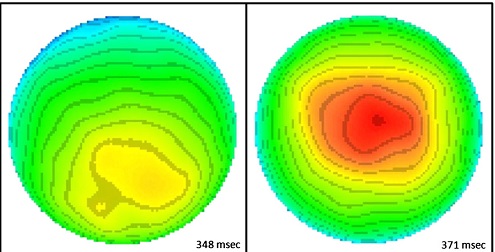 Police work routinely engages police officers in rapid decision-making situations in which the inhibition of a response may or may not result in a potentially detrimental if not catastrophic outcome. In spite of the repeated exposure of police officers to traumatic events, there are no studies, to date, that have examined the effects of trauma exposure on the neural basis of attention and decision-making in this population. In this study we are examining electrophysiological measures of response control processes under normal and degraded stimulus conditions using a visual Go/NoGo CPT task. The use of electrophysiological measures of attention, such as the ERP N2/P3 components, along with speed of motor responding, provides converging information about the cognitive operations of attentional/response control systems. Police officers with PTSD are being selected for this study because: (a) they provide a unique opportunity to further our understanding of PTSD in this important, yet under-studied group; (b) they are an immediately available population due to the collaborative arrangement between the PI at Buffalo General Hospital, and the co-investigator in the Department of Social and Preventive Medicine at the University at Buffalo; (c) police officers as a group have fewer confounding factors present, such as medications, co-morbid psychiatric conditions, alcohol/substance abuse, as compared to Vietnam veterans and other combat groups; (d) comparisons can be made between the present study and previous electrophysiological studies of PTSD by Shucard et al. (2008) and others.
Police work routinely engages police officers in rapid decision-making situations in which the inhibition of a response may or may not result in a potentially detrimental if not catastrophic outcome. In spite of the repeated exposure of police officers to traumatic events, there are no studies, to date, that have examined the effects of trauma exposure on the neural basis of attention and decision-making in this population. In this study we are examining electrophysiological measures of response control processes under normal and degraded stimulus conditions using a visual Go/NoGo CPT task. The use of electrophysiological measures of attention, such as the ERP N2/P3 components, along with speed of motor responding, provides converging information about the cognitive operations of attentional/response control systems. Police officers with PTSD are being selected for this study because: (a) they provide a unique opportunity to further our understanding of PTSD in this important, yet under-studied group; (b) they are an immediately available population due to the collaborative arrangement between the PI at Buffalo General Hospital, and the co-investigator in the Department of Social and Preventive Medicine at the University at Buffalo; (c) police officers as a group have fewer confounding factors present, such as medications, co-morbid psychiatric conditions, alcohol/substance abuse, as compared to Vietnam veterans and other combat groups; (d) comparisons can be made between the present study and previous electrophysiological studies of PTSD by Shucard et al. (2008) and others.
The goal of the current study is to use a neurobehavioral approach to determine if impairments in attention and decision-making are present in police officers with high levels of PTSD symptomatology, and to relate measures of decision-making to hyperarousal. To accomplish this goal, event-related brain potentials (ERPs) are being measured during a visual A-X continuous performance test (CPT) paradigm under conditions of normal and difficult (degraded) stimulus discrimination. ERP and behavioral performance measures are be compared among trauma-exposed police officers with PTSD and subsyndromal PTSD, trauma-exposed police officers without PTSD, and a non trauma-exposed civilian control group. Measures of target detection (Go), response inhibition (NoGo), and ability to screen irrelevant stimuli are being compared among the groups. These ERP measures of decision-making will be related to behavioral measures of hyperarousal. The localization of the underlying brain structures associated with response inhibition and processing of irrelevant stimuli are being conducted using dense electrode array source localization models.
